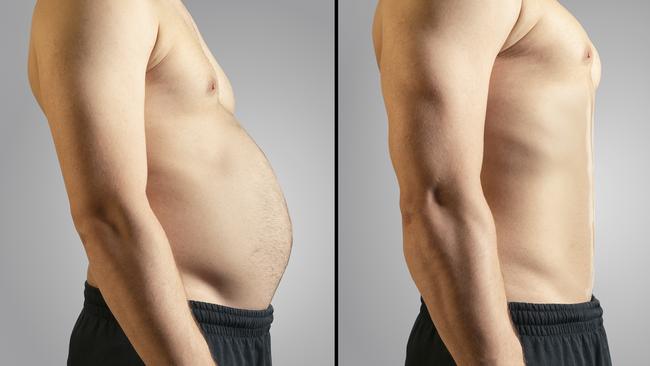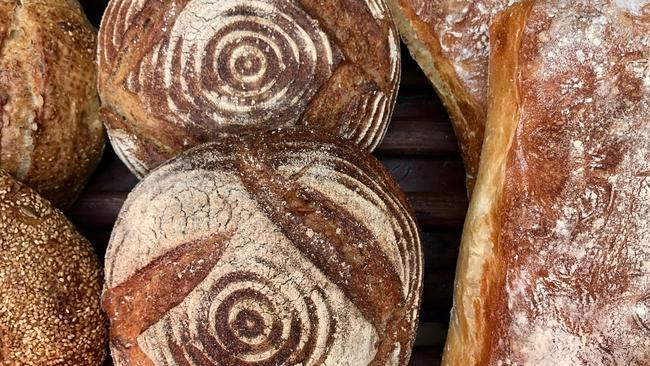Men, middle-aged spread and type 2 diabetes
A record number of men are at risk of type 2 diabetes, because of a gain in belly fat in middle age. Put simply, the paunch has to go.

So how is your waistline looking? If you’re male and it has expanded by a belt size or if a paunch has appeared over the top of your jeans in recent months, it is time to take swift action.
Men are more susceptible — in the most recent National Diabetes Audit in England, significantly more men (56 per cent) were diagnosed with type 2 diabetes than women (44 per cent) — and it’s a risk that increases with age.
Mike Gleeson, emeritus professor of exercise biochemistry at Loughborough University and the author of Eat, Move, Sleep, Repeat, says this is partly because of the way male bodies store fat.
“In women, fat tends to be more evenly distributed around the body,” he says. “In men, fat accumulates around their abdominal region and this bulge is a stark warning sign that their health is in danger.”
Roy Taylor, a professor of medicine and metabolism at Newcastle University, warns: “Men can be otherwise quite slim yet harbouring this dangerous, inflammatory fat around their waist and not appreciating how harmful it is.”
This is a sign that there is fat also settling around the organs, he says. And when too much fat is stored in the liver, the pancreas and around the abdomen, it prevents normal insulin release, which can lead to type 2 diabetes.

Type 2 diabetes is a serious condition where your blood glucose is too high and happens when your body doesn’t produce enough insulin or produces none at all. This is known as insulin resistance.
Gleeson, who has spent 40 years teaching and researching in the field of exercise physiology, metabolism, immunology and sport nutrition, has experienced first-hand the consequences of putting on added weight around the middle. Ten years ago, as his life became more sedentary — and his midriff spread — he was diagnosed with type 2 diabetes.
“I was not grossly overweight, but weight had crept on around my middle as I spent more time lecturing, less time playing sport, had more wine with my evening meals and was inactive in the evenings,” Gleeson says. “I got rid of the condition through a strict program of diet and exercise.”
So what is the best way to blast dangerous fat from your waistline? We ask leading experts for their top tips.
A man in his fifties should be the weight he was at 21
By the age of 21 your body is set up for life in terms of organ and skeletal maturity. Provided you were not obese at that age, you should aim to get as near as possible to 21-year-old body weight for life.
“Any additional weight you gain after 21 will be body fat,” Taylor says. “If you can’t wear the trouser or dress size you did at that age, you need to think about your weight.”
Gleeson says he reversed his type 2 diabetes by striving to achieve his 21-year-old weight. “As a young man I weighed 65kg but that crept up to 80kg by my fifties,” he says. “At 65 I now weigh 67kg and have got rid of my diabetes as a result.”

Sorry, but cut your alcohol intake
No getting away from this one — you need to cut down. “Alcohol is best described as liquid fat,” Taylor says. A single unit of alcohol contains 56 calories. A large glass of wine with three units contains 225 calories, a bottle of wine contains about 600 calories and a pint of beer, lager or cider contains 222 calories.
“Alcohol carries a huge calorie load and even more calories are added with syrups, mixers and flavourings,” Taylor says. “To lose weight you must limit your intake and have four or five alcohol-free days a week.”
Four hours’ exercise a week will reverse your risk of type 2 diabetes
“Exercise maximises fat burning and also improves insulin sensitivity as your muscles take up glucose from the blood without having to use insulin when you are active,” Gleeson says. “With every single bout of physical activity you do you are effectively reversing your risk of type 2 diabetes.”
In the landmark Finnish Diabetes Prevention Study people who did not reach a goal of losing 5 per cent of their initial body mass but who did manage to exercise for more than four hours a week had an 80 per cent lower risk of developing type 2 diabetes than participants who remained sedentary. “More needs to be learnt about the precise role of exercise in preventing type 2 diabetes, but it is abundantly clear that exercise makes a big contribution to avoiding it,” Gleeson says. “Add minutes and hours to the time spent moving and walking every day.”

Walk or run for 60 minutes to improve your body’s use of sugar
Short, sharp HIIT (high-intensity interval training) sessions will improve your fitness, but are not the best option for fat blasting, Gleeson says. “At high exercise intensities, fat oxidation is inhibited and instead of fat the working muscles use mostly carbohydrate as fuel. You also can’t keep it up for very long, which means only doing short-duration HIIT exercise is really no good for significant weight loss.”
Instead, aim to increase your moderate intensity continuous activity for bouts of an hour on at least three days a week. “You need to jog, walk, swim or cycle briskly for a sufficient duration, which is usually about 60 minutes to improve your muscles’ glycogen [sugar] uptake and trigger fat burning,” Gleeson says. “With that as a base you can then think about adding intervals and any additional workouts.”
A waist of over 94cm will impact your longevity (whatever your height)
A bulge above the waistband is a warning sign for your health. “The only reason you get a paunch is because you are getting too fat,” Taylor says. “There are no muscles in this bit that is expanding; it is purely an accumulation of excess body fat.”
It’s quite possible to have worked-out abs and still carry dangerous belly fat, he adds.
A tape measure is the best way to keep tabs on your middle. If your waist circumference is 94cm or higher, regardless of your height, you need to shrink it. And if your waist measurement is more than half of your height, it is a sign that you have too much belly fat. “You can be relatively slim and still carry this risky middle fat, which predisposes you to health problems including diabetes and heart disease,” Taylor says. “A tape measure is more useful than scales for keeping this in check.”

Cut back on pasta and bread to avoid risky blood sugar spikes
“White bread, pasta and rice, biscuits and cakes should all be reduced if you eat a lot of them,” Taylor says. “They are the kind of foods that also cause a sharp spike in blood sugar after eating them because they have a higher glycaemic index, or GI.”
Too many of these foods over time can affect your insulin sensitivity, dulling it, and consequently raise your risk of type 2 diabetes. A BMJ study showed how overweight adults who replaced these unhealthy carbs in their diet with fat boosted their metabolisms and after five months were burning about 250 calories more a day than people on a high-carbohydrate diet.
Emma Elvin, senior clinical adviser at Diabetes UK, advises to switch to high-fibre foods such as brown rice, wholegrain bread and cereals, fruits and vegetables, nuts and seeds, pulses, oats and barley.
“Fibre fills you up, helps to keep blood glucose under control and keeps the digestive system healthy, all of which will help with weight loss,” she says.
Eat between 8.30am and 4.30pm to keep your blood sugar levels stable
Research suggests that short periods of fasting — or a fasting window — have a positive effect on blood glucose levels and insulin secretion, something scientists attribute to metabolic switching — after 10 or 12 hours of no food the body depletes its supply of glycogen and starts burning ketones (made from fat by the liver) as fuel. “Most people find that an eating window of 8 hours and 16 hours’ fasting is generally easier than alternate-day or 5:2 fasting,” Taylor says. “But it is all about what works for you.”
If you opt for the 16:8 intermittent fasting approach, try having breakfast at 8.30am, which would mean your last meal would be at 4.30pm. A recent study presented at NDO 2021, the US Endocrine Society’s annual meeting, showed that people whose eating window was earlier in the day had lower blood sugar levels and less insulin resistance.
Gleeson says he mixes and matches dietary approaches, including fasting.
“If you struggle with sticking to one diet, I advocate switching approaches every week for 10 weeks,” he says. “Try the 5:2 diet, the 16:8, low carb, low fat or any diet that is not too extreme, as all of them work to the basic premise that you need to eat less. That will bring results.”
Drastically slash your calories if you are overweight
If you have a lot of weight to lose, you can afford to cut calories quite drastically. Taylor says that when calories are slashed, the fat that is stored in the pancreas and liver is used first for energy, leading to weight loss and reversal of type 2 diabetes. From his research, Taylor says that cutting your intake to 700 to 800 calories a day to start with can result in people losing as much as half a stone in the first month.
Initially, much of the weight lost is fluid, but then you will begin to lose fat. One way to do this is by using nutritionally complete meal replacement shakes that provide you with the calories and nutrients you need. In the Direct trial, funded by Diabetes UK and published in The Lancet, Taylor and a team of scientists showed that, for people who had type 2 diabetes, losing 10kg in weight on meal replacement shakes reversed the condition in a third of patients for up to two years. Once the weight is lost, you will of course need an “exit plan”.
“These diets can have huge benefits, but they are not a long-term solution and people can forget how to eat normal food after following them, so it is important to transition off them with care,” Taylor says.
“Replace one shake at a time with a meal of something like 100g salmon, broccoli and a small amount of potatoes, keep tabs on your waist measurements and gradually start reintroducing other meals when you are ready.”
The Times







To join the conversation, please log in. Don't have an account? Register
Join the conversation, you are commenting as Logout